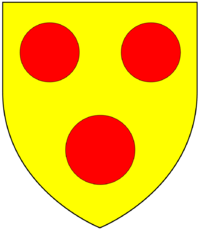Roundel (heraldry)

A roundel is a circular charge in heraldry. Roundels are among the oldest charges used in coats of arms, dating from the start of the age of heraldry in Europe, circa 1200-1215.
Different roundels
Roundels in British heraldry have different names depending on their tincture.[1] Thus, while a roundel may be blazoned by its tincture, e.g., a roundel vert (literally "a green roundel"), it is more often described by a single word, in this case pomme (literally "apple", from the French) or, from the same origins, pomeis — as in "Vert; on a cross Or five pomeis" (Scottish Public Register vol. 32, p. 26).
| Metals | Colours | |||||||
|---|---|---|---|---|---|---|---|---|
bezant coin |
plate plate |
hurt berry |
torteau cake |
pellet pellet |
pomme apple |
golpe wound |
orange orange |
guze eye |
A pellet may also be called an ogress.[2]
In French blazonry, a roundel of either metal (or or argent) is a besant, and a roundel of any colour (dark tincture) is a torteau, with the tincture specified. In German blazonry, the general word for a roundel is eine Kugel; a roundel of silver can also be called ein Ball, and a roundel of gold eine Bille.
Special roundels

Fountain
One special example of a named roundel is the fountain, depicted as a roundel barry wavy argent and azure, that is, containing alternating horizontal wavy bands of blue and silver (or white). Because the fountain consists equally of parts in a light and a dark tincture, its use is not limited by the rule of tincture as are the other roundels. Another name for the fountain is the syke (Northern English for "well").[3][4] One of the most well-known and ancient uses of the fountain is in the arms of the Stourton family.
Semy
In their earliest uses, roundels were often strewn or sown as seeds (Latin: semen -itis, a seed) upon the field of a coat of arms, blazoned as semée/semy, an arrangement with numerous varieties. For example, a field semy of plates (i.e. roundels argent) could be blazoned platy; a field semy of pellets (i.e. roundels sable) could be blazoned pellety. The precise number and placement of the roundels in such cases were usually left to the discretion of the artist.
See also
References
- ↑ Fox-Davies, Arthur Charles (1909). A Complete Guide to Heraldry. p. 151.
- ↑ Woodcock, Thomas; Robinson, John Martin (1988). The Oxford Guide to Heraldry. Oxford: Oxford University Press. p. 204. ISBN 0-19-211658-4.
- ↑ Fearn, Jacqueline (1980). Discovering Heraldry. Shire. p. 25.
- ↑ Scottish National Dictionary of 1700: syke
